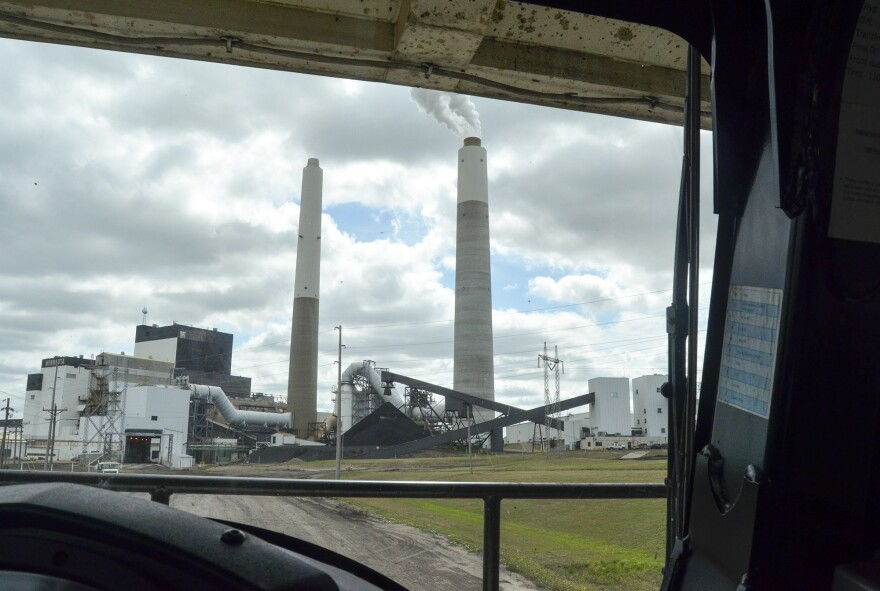From Stan Burling’s house at the end of Main Street, it’s a minute walk to downtown Hazen in central North Dakota.
The street sports a thriving business community in this town of 2,400 with amenities like a drug store, an insurance company, a Chevy car dealer.

Power plants surround Hazen, along with the coal mines that feed them.
“They support the local economy,” Burling said.
About half the residents work in the industry, or in a related job.
“They buy their vehicles here, groceries, support the local retail businesses,” he said.
Burling works down the highway as a control room operator at the coal-fired Leland Olds Station, a power plant owned by Basin Electric Power Cooperative. The plant turns lignite coal into electricity, like all but one of the state’s eight coal plants.
Lignite is a soft coal — more plant than rock. It doesn’t burn as hot as older, denser coals. That means power plants have to burn more of it to generate the same amount of electricity.

While that might seem like a disadvantage, there’s onlyone power plant that has recently announced it will shut down in North Dakota.
It’s the only one that doesn’t burn lignite.
“It wasn’t a surprise, but it still wasn’t exactly a thing I wanted to open the paper and see,” Burling said.
It’s the first market casualty to hit coal country in North Dakota. Nationwide, more than 250 generators at coal plants were retired from 2010 to 2014.
The closure next door concerns lignite workers like Burling, who don’t want to see a statewide coal shutdown.
“A lot of people are like this is how it’s going to start,” he said.
But so far, the rest of North Dakota’s coal plants and mines have held steady. The lignite industry here says its resilience lies in the way it operates.
Pressure Mounts In Coal Country
At the Center Mine, 30 miles southeast of Hazen, the coal’s dumped onto trucks. They haul it just a couple miles to the power plant.

For most of the country’s coal-powered plants, transportation is 40 percent of the costs. Lignite plants are cheaper to run because they’re built right next to the mines.
“It’s really more like a marriage,” said Wade Boeshans, president and general manager of BNI Energy, which owns the Center Mine.
He said mines work closely with their neighbor utilities.
“They’ve agreed to work together for 30 or 40 or more years,” he said.
Elsewhere, natural gas is often to blame for the demise of the coal industry. But it’s not widely used for electricity in North Dakota.

Here, it’s wind that poses a threat, said Jason Bohrer, president and CEO of North Dakota’s Lignite Energy Council.
Over the past decade, wind farms have boomed in North Dakota. Wind turbines now generate nearly 18 percent of the state’s electricity mix. That’s up from 1 percent a decade ago.
That was one of the factors leading to the decision to shut down the coal-fired power plant. Other factors include low electricity prices and the fact that the plant was small, old, and needed an expensive upgrade to comply with federal clean air regulations. On top of all that, the cooperative that owns the plant says it’s no longer needed and won’t be replaced.
That troubles Bohrer.
“When power plants have shut down in the past, they have been replaced with power plants,” he said.
More pressure comes from another looming federal regulation, the Clean Power Plan. If that plan is implemented, North Dakota must cut its carbon emissions 45 percent by 2030.
Many states, including North Dakota, have sued to stop the rule. If it’s upheld, it won’t matter if lignite mines are 1 mile or 100 miles from power plants. Lignite emits more carbon dioxide in generating electricity than harder coal.
“We have to come up with a solution in the next two or three years,” he said.
Searching For Plan B
They’re trying. The state of North Dakota has invested $5 million in a partnership with the lignite industry to build a zero-emission power plant that would convert lignite to natural gas, and capture carbon dioxide for enhanced oil recovery. But this plant still needs years of research and testing before it’s ready to roll out in North Dakota.
“If that doesn’t work, we are going back to the drawing board, but that drawing board is empty,” he said.
Back in Hazen, coal workers like Burling want to keep their jobs.
The 53-year-old left a long career with the local sheriff’s office more than a decade ago, eager to do away with the instability of a new boss every election. Now, it’s his current industry’s volatility that weighs on his mind.
“I’ve got to be honest,” he said. “I haven’t come up with a Plan B yet.”
Neither has the state’s coal industry.













